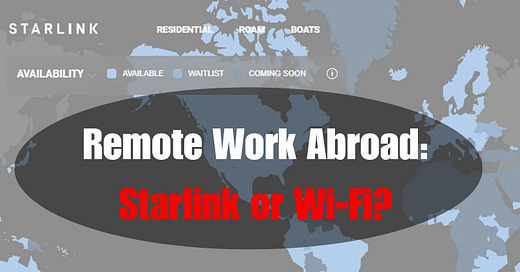Starlink vs. Wi-Fi: Comparing Internet Options for Remote Work Abroad
Starlink Mini is portable version of their satellite internet dish is the size of a book and easily fits into a backpack, making it a practical solution for those on the move.
Highlights
Reliable internet: Starlink works well even in remote areas, often better than hotel Wi-Fi or phone tethering.
Fast speeds: Download speeds are 50-150 Mbps, great for video calls and remote work.
Congestion issues: Speeds may slow during busy times due to network congestion.
In the era of remote work and digital nomadism, staying connected is more crucial than ever. Whether you are working from a beach in Bali, a café in Paris, or a cozy Airbnb in Tokyo, reliable internet access is a must. There are several ways to ensure you remain connected while working holidays abroad, including using the hotel or Airbnb Wi-Fi, tethering to your phone, and the emerging option of satellite internet, particularly Starlink. This article compares these methods, focusing on download speeds, latency, availability, and why Starlink is becoming the preferred choice.
This is not only for those remote workers taking a workation in Bali. This is also for those WFH full time who want to use their family's cottage or cabin in the woods but until now have been prevented from doing so by the threat of not fulfilling their work obligations.
Hotel or Airbnb Wi-Fi is often the first option and the most obvious many consider. In urban areas, this can offer download speeds from 10 to 50 Mbps, sufficient for most remote work tasks. However, the quality of these connections can vary significantly. In less developed or rural regions, speeds can drop below 5 Mbps, leading to frustrating interruptions and decreased productivity. Furthermore, the number of users on a shared network can cause significant slowdowns and packet loss, particularly during peak hours. Latency, the time it takes for data to travel to and from the server, generally ranges from 20 to 150 ms. Anything below 100 milliseconds in videoconferencing is acceptable, even though the 20-40 milliseconds range is considered optimal. This variability can impact activities like Zoom calls and real-time collaboration.
Tethering to a mobile phone provides another alternative, with speeds largely dependent on the mobile carrier and network type. 4G LTE networks typically offer download speeds between 5 to 50 Mbps, while 5G networks can exceed 100 Mbps in areas with strong coverage. This can make tethering a competitive option in urban settings. Latency on mobile networks is usually very good, typically around 30 to 50 ms on 4G and can drop to 10 to 30 ms on 5G networks, making it suitable for most remote work needs. However, availability can be a significant issue, particularly in rural areas or regions with challenging geography. Additionally, international travel introduces complications such as roaming charges and varying service quality, which can hinder consistent connectivity. In that case, buy a local e-sim to mitigate these issues. But this may not be the most suitable alternative if you are considering working while holidaying on some exotic, remote beach.
The third alternative we are going to talk about is Starlink. Satellite internet is nothing new. For decades, satellites have been used to provide internet access in remote regions. What really changed with the launch of Starlink in 2019 is that this company uses hundreds of small low Earth orbit (LEO) satellites. This makes it possible to offer impressive download speeds ranging from 50 to 150 Mbps, with the potential for even higher speeds as the network expands. This consistency often outperforms many hotel Wi-Fi networks and matches or exceeds mobile tethering, particularly in remote areas where terrestrial internet services struggle.
Availability is where Starlink truly excels. Its satellite constellation ensures coverage in even the most remote locations, far surpassing the reach of terrestrial networks. For digital nomads traveling to rural or isolated areas, this means reliable internet access where traditional methods fail. In this regard, Elon Musk's company has recently launched the Starlink Mini. This portable version of their satellite internet dish is the size of a book and easily fits into a backpack, making it a practical solution for those on the move.
Keep reading with a 7-day free trial
Subscribe to 24Hour Journal to keep reading this post and get 7 days of free access to the full post archives.





